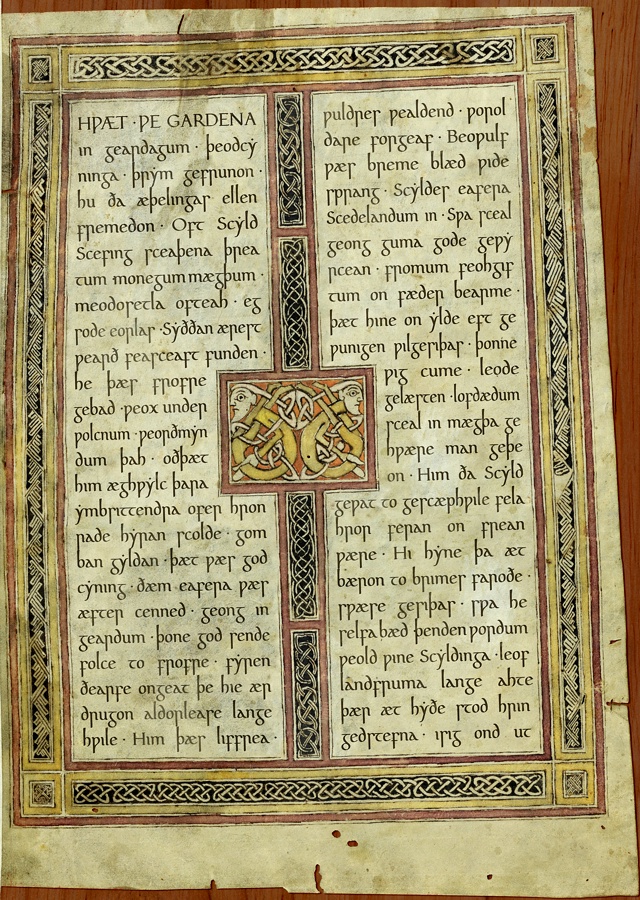

Pfeffer Mediæval, used to depict a page from the Lay of Hildebrand and another one from the epic poem of Beowulf.
Pfeffer Mediæval is the idealised image of a Carolingian minuscule, the script of Charlemagne, on which our modern Antiqua has been modelled.
In the young kingdoms that had been founded on formerly Roman territory during the migration period, several so called Post-Roman scripts emerged up to the 8th century. These were already minuscule scripts using ascenders and descenders. Although all of them were derived from uncial, half uncial and new Roman cursive, they differed quite a lot regionally. Moreover, they were difficult to read, not least due to their extensive use of ligatures. Beginning from the end of the 8th century a standardisation took place in the course of the Carolingian Renaissance. Advocated by Charlemagne and with important collaboration of Alcuin of York—who had responded to a call to Charlemagne’s palace school in Aachen — an easy to read script was developed that, beginning from the 9th century, quickly spread across the Frankish scriptoria. This Carolingian minuscule became the common book and administrative script in the Carolingian empire and all over western Europe except Ireland, until it was in turn replaced by the Gothic minuscule script.
In England, where the new script took a very belated foothold, the insular minuscule script (one of the above mentioned Post-Roman scripts) was in coeval use up to the 12th century. This insular hand script primarily differs from the continental one in the shape of a few letters.
Being my most extensive font as yet, Pfeffer Mediæval contains more than 800 glyphs the whole of which cannot be displayed here. The Latin range includes numerous accented letters and additional characters for purposes of medieval philology. As far as the coverage reaches, the character mapping follows the recommendations of the Medieval Unicode Font Initiative. Among those additional characters are several insular variants of Latin letters, rendering Pfeffer Mediæval suitable for display of Old English texts as well.
Finally, this font also encompasses a Gothic and a Runic character set.
Pfeffer Mediæval contains OpenType features for historical text layout, insular script and Gothic alphabet as well as for small capitals and particularly large capitals.
Activating the “hist” feature for historical text layout generates a typeface that comes closer to the historic customs in writing Carolingian minuscule. The umlauts ä, ö and ü are replaced by ligatures like æ and œ, v is replaced by u and w by uu, i is replaced by ı and finally s by ſ. Punctuation is reduced to mid-dot (“·”), and all marks (or combinations of such) are replaced accordingly. The following example shall give a demonstration:



In order to make this feature available in Microsoft Word 2010 (which supports just a few OpenType features, including the stylistic sets), I’ve added a copy of this feature as stylistic set “ss05”.
The “smcp” feature for small capitals is illustrated by the personal names in the following example:

For use in Word 2010 this feature is also available as stylistic set “ss06”.
By activating stylistic set “ss01” capital letters are replaced by even larger majuscules looming somewhat down to the descenders:

The activation of stylistic set “ss02” substitutes several characters by their insular variants, allowing for the display of Anglo-Saxon texts, as pointed out by the following example:



The role of stylistic sets “ss03” and “ss04” for using the Gothic and the Runic alphabet is described on the respective pages concerning the Gothic and the Runic character set of Pfeffer Mediæval.
Reconstruction of a page from the presumed upper German draft of the Lay of Hildebrand (text according to Georg Baesecke, Das Hildebrandlied, Halle 1945):
From a ‘sparsely known’ Beowulf manuscript (the parchment background with its frame pieces originates from Codex Sangallensis 1395, fol. 422):

| File | Description |
| pfeffer_mediaeval.zip | A Carolingian minuscule font with a vast character set. |
